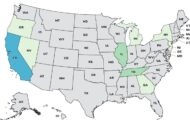The current outbreak of E. coli in Canada that may be linked to leafy greens is nothing new. According to a University of Georgia research project, E. coli bacteria in leafy greens ranked as the first of the 53 pathogen-product commodity pairs in outbreaks from 2000 to 2007. There were 28 E. coli outbreaks linked to cabbage, lettuce, spinach, sprouts, and leafy green salads during that time frame.
 The FDA issued the revised Product Safety Rule in September 2014. The rules cover testing of water used in surface irrigation, the amount of time between field application of manure and crop planting, and has redefined labels on “farms” and “mixed use facilities” that streamline inspections during the harvest, storage, and packing steps.
The FDA issued the revised Product Safety Rule in September 2014. The rules cover testing of water used in surface irrigation, the amount of time between field application of manure and crop planting, and has redefined labels on “farms” and “mixed use facilities” that streamline inspections during the harvest, storage, and packing steps.
A 2013 CDC study found that leafy greens are a leading source of food poisoning. That study showed that 46% of foodborne illness outbreaks are attributed to produce, although more deaths are attributed to pathogens in poultry than to all other commodities.
The government looked at 4,589 outbreaks between 1998 and 2008. Norovirus in produce were the largest cause of outbreaks. In fact, 2.2 million illnesses were associated with leafy vegetables, which indicates that those vegetables are found in complex foods. Dairy was the next most common vehicle for these pathogenic bacteria.
Leafy greens can be contaminated in the field through dirty irrigation water, manure used as fertilizer, animal feces, improper handling during harvest, storage, and transport, and during packaging. What does this mean for consumers?
The government wants consumers to eat more vegetables. But you can take some steps to help protect yourself and your family. Always rinse leafy greens well under cool running water before preparing them. Bagged produce is considered safer; most experts recommend that you do not rewash those products, since you may re-contaminate them during that process. Always buy bagged produce with the furthest “use by” date. Refrigerate all produce and be careful in the kitchen to avoid cross-contamination.
The outbreak in Canada has sickened at least 12 people who are infected with bacteria that have the same genetic fingerprint. Since leafy greens are often imported to Canada from the U.S. and Mexico, there could be people sickened in the U.S. as well.
If you have experienced the symptoms of an E. coli infection and have eaten leafy greens recently, please see your doctor. Early treatment is necessary to avoid serious complications such as hemolytic uremic syndrome (HUS). For instance, if antibiotics are given as treatment for this type of infection, the risk of HUS increases.
The symptoms of an E. coli infection include severe stomach and abdominal cramps, diarrhea that is bloody and/or watery, nausea, vomiting, headache, and a slight fever. If the illness progresses to HUS, liver failure and death may occur.




